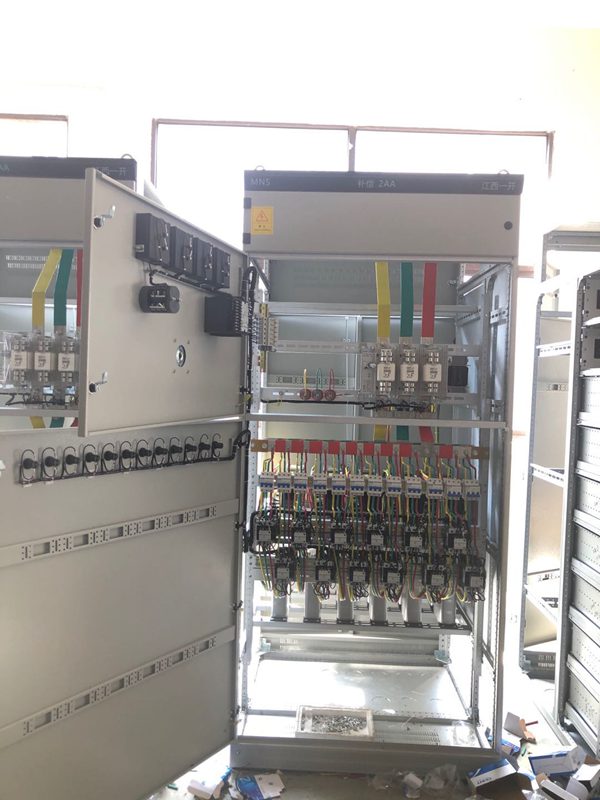We often see low-voltage power factor correction, or high-voltage power factor correction panel in power distribution rooms.
The reactive power compensation switchgear installed on the side of the high-voltage cabinet is called high-voltage concentrated compensation; the one installed on the low-voltage side is called low-voltage on-site compensation, and the majority of the low-voltage on-site compensation is basically the majority.
What role do they play? What is the principle? Jiangxi Yikai Electric will analyze it for you.
(1) The low-voltage power factor correction switchgear is connected in parallel to the low-voltage bus.
The internal components of the low-voltage reactive power compensation switchgear are: knife switch, current transformer, circuit breaker, AC contactor, thermal relay, compensation capacitor, low-voltage surge arrester, etc. High-voltage capacitors are similar, but all internal components are replaced with corresponding high-voltage grades, and the overall look is much larger than that of low-voltage capacitor cabinets.
At present, there are no thermal relays inside many reactive power compensation switchgear. In the place of thermal relays, a small reactor is used to suppress line current mutation and harmonics, thereby protecting the compensation capacitor at the end.
(2) why do we need power factor correction?
Reactive power is just the conversion of electrical energy, not the power consumed. We all know that electrical equipment has three properties: resistive, capacitive and inductive. Resistance is well understood. In the form of resistance, current is consumed through resistive components. For example, an electric hair dryer heats the air blown out through a resistance wire, so that electrical energy is converted into thermal energy.
Capacitive and emotional are different. Capacitives, such as capacitors, only store electrical energy and can be released when needed; inductive, such as reactors, convert electrical energy into a magnetic field and save it. Therefore, in a sense, they do not do work, so it is called “reactive power”.
However, reactive power is not useless, it is actually the foundation of industry. Without reactive power, only the active power generated by resistive components cannot establish today’s industrial prosperity. Most commonly, the motor needs to establish and maintain a rotating magnetic field to rotate the rotor to drive mechanical motion.

The rotor magnetic field of the motor is established by obtaining reactive power from the power supply.
Transformers also require reactive power in order for the primary coil of the transformer to generate a magnetic field and induce a voltage in the secondary coil.
Therefore, without reactive power, the motor will not rotate, the transformer cannot be transformed, and the AC contactor will not pull in.
Therefore, under normal circumstances, electrical equipment not only consumes active power, but also needs to obtain reactive power from the power supply.
1) If the electric equipment does not have enough reactive power to establish a normal electromagnetic field, these electric equipment cannot maintain the rated conditions, and the terminal voltage of the electric equipment will drop, thus affecting the normal operation of the electric equipment.
2) If the electrical equipment does not have enough reactive power, requesting reactive power from the grid will increase the loss of the grid and increase the voltage drop of the line, which will affect the normal operation of the entire grid.
Therefore, there will be capacitance compensation cabinets in the power distribution room for on-site compensation; and the power supply companies generally require the power factor of capacitance compensation to reach more than 0.9.
The power supply company also does not allow too much reactive power to be transmitted to the grid, which will cause the line voltage to increase.
Therefore, the capacitor compensation cabinet generally has a switching switch, when it is switched to the “automatic” position, the required amount of capacitor can be input according to the actual situation.
(3) How appropriate is the capacitance compensation?
Taking a 500kVA transformer as an example, in general, the reactive power compensation capacity of the distribution transformer is about 20% to 40% of the transformer capacity. The general designer estimates it by 30%, that is, 150Kvar is selected as the maximum compensation capacity, and Is the installed capacity. The following is the reactive power compensation scheme for a 500kVA transformer:
1) Reactive compensation capacity: 150kvar 3×40kvar (20kvar 20kvar) 1×30kvar (20kvar 10kvar)
2) Number of smart capacitors: 3 sets of SWL-8MZS/450-20.20 1 set of SWL-8MZS/450-20.10
If there are motors, frequency converters and other equipment, the algorithm of reactive power compensation is different from that of transformers.
The required reactive power compensation capacity can also be calculated by comparing the power factor before and after compensation, for example:
1) The active power of a factory is 600KW, the reactive power is 800Kvar, the apparent power is 1000KVA, and the corresponding power factor is 600/1000=0.6.
2) Query the coefficient table of reactive power compensation capacity, and find the corresponding coefficient F according to before and after compensation. If it is 0.6 before compensation and 0.95 after compensation, you can find the coefficient F=1.005
3) Through the calculation formula: active power * coefficient F, it is equal to the total reactive power to be compensated. 600*1.005=605kvar.
4) According to the actual situation, some margin can be appropriately enlarged to prevent the lack of reactive power after the subsequent addition of equipment.